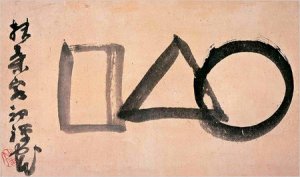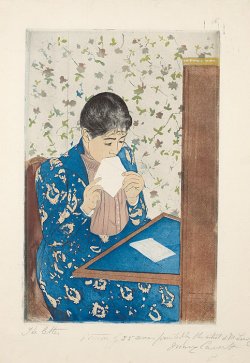Review of the Solomon R. Guggenheim Museum exhibition, “The Third Mind: American Artists Contemplate Asia, 1860-1989.”

Sengai Gibon, The Circle, Triangle and Square. Edo Period, early 19th century.
Until surprisingly recently, conventional wisdom held that anything from the East that resembled contemporary work produced in the West was derivative, and yet anything that didn’t resemble work produced in the West was unsophisticated and naïve. Alexandra Munroe‘s “Scream Against the Sky: Japanese Art After 1945,” at the Solomon R. Guggenheim Museum in 1994, was one of the first major museum shows in New York to correct that perception. Even the New York Times expressed wonderment that “[a]nyone who regards contemporary Japanese art as a watered-down version of Western modernism has a surprise in store. Many of the artists included here have been pioneers in styles – Conceptualism, performance art, body art – that America and Europe tend to claim as their own.” In our current moment of CaiGuo Qiang on the roof of the Met and Yayoi Kusama at Gagosian, it is hard to remember just how exotic the show looked a mere fifteen years ago.
Munroe recently offered her own sort of reply to that exhibition with “The Third Mind: American Artists Contemplate Asia, 1860-1989,” which is essentially the inverse. “Scream Against the Sky” revealed that the modern artistic imagination existed in Asia, well outside Western boundaries, but “The Third Mind” demonstrated that Western modernism was at least partly formed outside those boundaries. Having ceased to disparage Asian contemporary art as plagiaristic of a Western vision of modernism, we must now reckon with the idea that Western modernism was in some ways plagiaristic of Asia.

Mary Cassatt, The Letter, 1890-91.
In order to make this argument, Munroe had to get past the charming Orientalism of ukiyo-e blocks of color and little architectonic pagodas – the stuff that was not conceptually influenced by Asian art as visually appropriative of it. “The Third Mind” proposed that while calligraphic brushwork offered technical inspiration to a number of American artists, the greatest impact was a blurring of lines between language and visual representation. Further, while artists such as Meredith Monk and John Cage learned presentation styles from traditional Asian performance, much of Minimalism derived from an appreciation of ancient Zen principles: of the specific beauty of a cadenced simplicity, of transcendence found in visual and conceptual purity, and of knowing and respecting the physical essence of materials.
Some of the exhibition’s iconic works of postwar American art are frankly Asian-influenced, such as James Lee Byars‘s lush and golden installation The Death of James Lee Byars, 1982/1994, which ushered viewers into the show; Robert Motherwell‘s ink paintings; and Brice Marden‘s guohua-inspired abstractions. Less likely candidates, such as Franz Kline‘s blocky canvases, a Sam Francis that is mostly white space, and striking Jackson Pollock monochrome paintings from 1950, gained new depth when presented in this context. Would Fluxus have been possible without Asian traditions of celebrating temporality? Lawrence Ferlinghetti and Robert Rauschenberg also drew from this intellectual provenance. In fact, after you had walked through the exhibition, you were left to wonder whether there is such a thing as modern American art that is not conceptually based on Asian transcendentalism.
As significant as the exhibition is a catalogue that investigates the relationship of this art to literature, music, and performance. It proposes an Asian foundation for the very idea of art as theater, an experience that unfolds sequentially – the principle, one might say, of the twentieth-century avant-gardes. The work of Ernest Fenollosa, perhaps the greatest translator of Asian sensibility for broader American consumption, is revealed as a brilliant misprision that allowed Western minds to form their own beautifully distorted ideas of Eastern philosophy. The Beats are shown to be foolishly smug about and hopelessly overwhelmed by Asian metaphysics, so that Kerouac can write, “Who knows, my God, but that the universe is not one vast sea of compassion actually. … In fact who knows but that it isn’t the solitude of the oneness of the essence of everything, the solitude of the actual oneness of the unbornness of the unborn essence of everything.” “The Third Mind” catalogue exposes the fine edge between the tedious self-indulgence of such exposition and the rigor that informs the Asian visions of oneness and unity on which it relies

James McNeill Whistler, Nocturne: Blue and Gold, Old Battersea Bridge, 1872.
“The Third Mind” demonstrated that cross-fertilization, no matter how indirect or circuitous, has always been alive in the realms of aesthetics, philosophy, and even consciousness. By displaying the work of both the relatively minor artists who were the conduit for these revelations and the major artists who integrated them without fully comprehending their origins, the show made a convincing case that we absorb influences through a Jungian collective unconscious that is both contemporary and historical. At a time when we were at war in the Pacific or recovering from that war, we were also engaging in cultural exchange, and the incorporation of Eastern philosophies was nothing short of a cerebral Marshall Plan in reverse. Indeed, the proliferation of such transcultural exhibitions as “The Third Mind” indicates that since we named globalism, we have begun to see it everywhere – and have discovered that it is no more modern than the Judd-like minimalism produced in Japan a thousand years ago.











